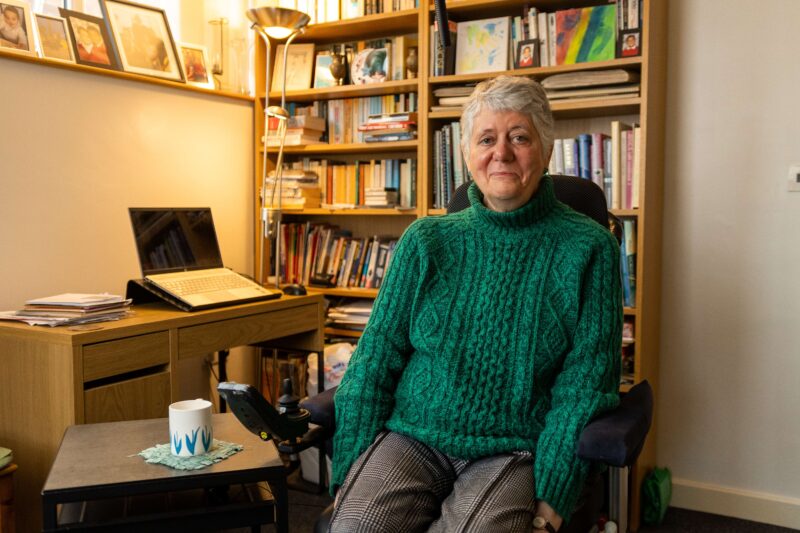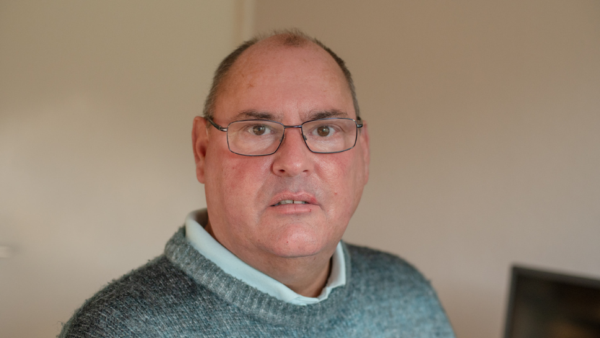Our condition-specific alert cards provide crucial information for emergency healthcare professionals treating patients with muscle wasting conditions.
Facioscapulohumeral muscular dystrophy (FSHD)
Facioscapulohumeral muscular dystrophy (FSHD) is a genetic condition that causes progressive muscle weakness that primarily affects the face, shoulders, and upper arms. Symptoms usually become noticeable in early adulthood, though they may appear later if mild.
There are two types of FSHD. Both present with similar symptoms and are caused by genetic changes that affect the activity of the DUX4 gene:
- FSHD type 1: This is the most common type, making up 95 percent of FSHD cases. It’s caused by a change in the D4Z4 region on chromosome 4.
- FSHD type 2: This rarer form is linked to changes in the SMCHD1 gene, which affects the D4Z4 region. In FSHD type 2, there is no genetic change in the D4Z4 region itself.
Early-onset FSHD is a rare subtype of FSHD that begins in childhood. Children with early-onset FSHD tend to have a more rapidly progressive weakness and have additional health issues.
The symptoms and severity of FSHD vary greatly, even between family members. While some may experience only mild symptoms throughout their lives, others may have more significant challenges.
Muscle weakness
Muscle weakness in FSHD typically affects the face, shoulders, and upper arms, before sometimes progressing into other muscles. One side of the body may be affected more than the other. Weakness around the shoulders can make it difficult to lift the arms above shoulder height and it may cause scapular winging (when the shoulder blades rise and stick out more). Weakness in facial muscles can make it difficult to close the eyes completely or purse the lips. In cases of severe facial weakness, speech and the ability to display typical emotional expressions can be affected.
At a later stage of the condition, some people may experience weakness in the torso, spine, and leg muscles. The development of torso and spine weakness will affect posture and can lead to lumbar lordosis (the exaggerated inward curve of the spine). Weakness in the lower legs can cause foot drop (difficulty raising the foot), making climbing stairs and walking on uneven surfaces difficult. People with FSHD may have a backward-leaning and high-stepping style of walking. They may be prone to falls because of reduced balance. Some may eventually require a wheelchair, especially for longer distances.
Pain
People with FSHD often have chronic musculoskeletal pain, especially in the neck, shoulders, and lower back, which is indirectly caused by muscle weakness in FSHD.
Respiratory
Respiratory function is usually well maintained in FSHD, with only around 1 in 100 people requiring overnight ventilatory support. However, about 1 in 10 people with FSHD have some weakness in the chest wall muscles, which can affect lung function. Weakness of the diaphragm and expiratory muscles can lead to reduced lung function and a weak cough. Overnight breathing problems are uncommon but may result in daytime sleepiness, morning headaches, poor appetite, and weight loss. Most people with FSHD do not have significant respiratory issues.
Genetic changes
Our DNA usually has repeated sections. In people with FSHD type 1, there are fewer DNA repeats in the D4Z4 region on chromosome 4. These repeats normally act as a block to keep the DUX4 gene turned off. With fewer repeats, this block becomes weaker, allowing the DUX4 gene to switch on and produce DUX4 protein, which causes inflammation and damage inside the muscle cells.
In FSHD type 2, a change in the SMCHD1 gene on chromosome 18 switches on the DUX4 gene, leading to similar muscle damage and symptoms.
Inheritance
FSHD is usually inherited in an autosomal dominant pattern, meaning that only one copy of the changed gene is needed from either parent to have the condition. In some cases, a person with FSHD has not inherited the condition from either of their parents, and the genetic change occurred spontaneously. This is called a de novo genetic change.
For more information, see our inheritance and genetics page.
A GP can make a referral to a neurologist for testing if there are signs of a muscle wasting condition. A neurologist is a doctor specialising in diagnosing, treating, and managing conditions that affect the muscles and nervous system. Diagnosis of FSHD typically involves a combination of physical examination, family history, and genetic testing. In most cases, FSHD can be confirmed using a blood test.
For more information, see our diagnosis page.
A multi-disciplinary approach, which involves different healthcare teams working together, is important in not only managing the condition and symptoms, but in improving wellbeing too. FSHD varies among people in terms of symptoms, age of onset, and severity – and so will the management required.
Access to a healthcare team
People with FSHD should have access to a multi-disciplinary healthcare team. Usually, the lead professional will be a neurologist. If you do not have contact with a neurologist or specialist doctor, speak to your GP about getting access to one.
Exercise and physiotherapy
Staying active is important and specialist physiotherapists can provide advice on healthy activities and suitable exercise. A physiotherapist is a healthcare professional who helps manage symptoms through movement, exercise, and manual therapy. Physiotherapists can help create a suitable exercise plan and provide advice on postural and fatigue management. Regular activity and exercise can help manage pain and maintain the muscle strength of non-affected or minimally affected muscles. This may also help people to stay independent for longer. After exercise, allow time to fully recover the next day. Some muscle soreness is okay, but this should not be severe pain and should improve over time. To find out more about advice for adults, see exercising with a muscle wasting condition.
Orthotics
Orthotic devices are supports or braces used to help manage muscle weakness, assist with walking, and support posture. Common options include ankle-foot orthoses (AFOs) to manage foot drop, and shoulder supports to manage scapular winging. These can be prescribed by an orthotics team after referral from a GP or specialist. Orthotics services need to be contacted again if supports and braces are uncomfortable or do not fit properly so that adjustments can be made.
Eyes
If those affected are unable to fully close eyelids while sleeping, it can lead to dry eyes. In severe cases, this can lead to corneal ulcers. Using eye lubricants can protect the eyes and prevent irritation. These issues can be discussed with the healthcare team and regular eye checks are recommended.
Speech
If facial weakness begins to affect speech, a speech and language therapist can carry out an assessment. Speech therapy can help people improve their speech clarity and communication skills. This may include exercises to strengthen speech muscles, techniques to improve articulation, or strategies to make up for speech difficulties.
Respiratory
As some people experience respiratory weakness, it’s important to monitor respiratory function with forced vital capacity (FVC) testing at review appointments. Overnight sleep studies may also be necessary to assess breathing during sleep. Chest infections should always be treated promptly. If necessary, cough augmentation techniques and chest physiotherapy may be recommended.
Early-onset FSHD, also called infantile or childhood-onset FSHD, is a form of FSHD that typically starts before the age of 10. It usually progresses more quickly and is more severe. It causes muscle weakness and wasting, usually affecting the face, shoulders, and upper arms first, and causes additional health issues. Generally, the earlier symptoms start, the more severe the condition will be.
Symptoms of early-onset FSHD
Muscle weakness and wasting is the primary symptom. It often begins in the face and shoulders. It can include:
- Facial weakness – difficulty closing the eyes, whistling, or showing typical facial expressions. The face may look thin or expressionless.
- Shoulder weakness – difficulty lifting the arms and scapular winging (when the shoulder blades rise and stick out more).
- Weakness in the arms and legs – this can make climbing stairs, getting up from a chair, or walking difficult. People sometimes develop foot drop (difficulty lifting the foot and toes).
Muscle weakness can progress rapidly. Children may have trouble walking or running and some may eventually lose the ability to walk on their own. A wheelchair may be needed by the time of adolescence or early adulthood.
Other possible symptoms include:
- Hearing loss – this is common and can worsen over time.
- Eye problems – problems with the blood vessels in the retina can occur and potentially affect vision.
- Breathing difficulties – weakness of the breathing muscles is possible, though less common.
- Heart problems – these are rare but can occur.
- Asymmetrical weakness – one side of the body may be weaker than the other, especially early on.
- Curved spine – the spine may develop a sideways curve (scoliosis) or inward curve (lordosis).
- Learning and behaviour – some children may experience mild learning or behavioural challenges.
- Pain and fatigue – muscle pain and tiredness are common.
The severity of early-onset FSHD can vary widely, even among family members.
Condition management
Condition management requires a multi-disciplinary approach focused on symptom relief and maximising quality of life. Because of the faster progression of early-onset FSHD, children are likely to need medical support as soon as symptoms appear. A team of specialists, including neurologists, physiotherapists, audiologists, ophthalmologists, orthopaedic surgeons, and genetic counsellors, is crucial.
Treatment and support include:
- Muscle Weakness – exercise, assistive devices (such as braces or wheelchairs), and possibly medication for pain or fatigue.
- Pain – pain management techniques, including medication if needed.
- Fatigue – strategies to save energy and assistive devices to make movement easier.
- Hearing loss – hearing aids or surgery to improve hearing.
- Vision Problems – regular eye exams and treatment if needed.
- Scoliosis – bracing or surgery, depending on severity.
- Additional support includes nutritional guidance and emotional support.
Regular check-ups with the healthcare team are essential to monitor changes and adjust care as needed.

Author: Muscular Dystrophy UK
Reviewers: Dr Enrico Bugiardini, Dr Charlotte Dougan, and Dr Rajesh Madhu
Last reviewed: March 2025
Next review due: March 2028
Facioscapulohumeral muscular dystrophy (FSHD) webinar (2024)
On Thursday 20 June 2024 we held a webinar on FSHD. Watch to learn about the latest research, as well as tips and advice on living well with FSHD.

We are here for you
Webinars, Information Days, and support groups for our muscle wasting community. Our life-changing support is here for you.
Advice for living with or caring for someone with a muscle wasting condition.


